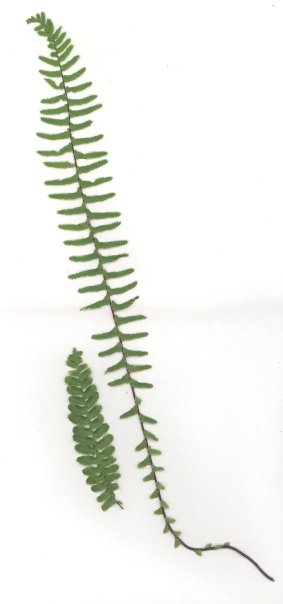
Wikipedia description
Asplenium platyneuron (syn. Asplenium ebeneum), commonly known as ebony spleenwort or brownstem spleenwort, is a fern native to North America east of the Rocky Mountains and to South Africa. It takes its common name from its dark, reddish-brown, glossy stipe and rachis (stem and leaf axis), which bear a once-divided, pinnate leaf. The fertile fronds, which die off in the winter, are darker green and stand upright, while the sterile fronds are evergreen and lie flat on the ground. An auricle at the base of each pinna points towards the tip of the frond. The dimorphic fronds and alternate, rather than opposite, pinnae distinguish it from the similar black-stemmed spleenwort.
The species was first described in 1753 by Linnaeus as Acrostichum platyneuros, although Linnaeus' type drew on material from several other species as well. It was more commonly called Asplenium ebeneum, a name published by William Aiton in 1789, until the rediscovery and revival of the Linnaean epithet in the late Nineteenth Century. A number of forms and varieties of the species have been described, but few are recognized today; in particular, larger and more fertile specimens, those with more or less toothed leaves, and those with proliferating buds are considered to fall within the natural range of variation of the species, and do not require taxonomic distinction. A. platyneuron f. hortonae, a sterile form with the pinnae cut to toothed pinnules, and f. furcatum, with forking fronds, are still recognized.
The formation of proliferating buds is one of several unusual adaptations for reproduction in this species. The buds form near the base of the stipe, and when covered with soil, can grow into new individuals as the frond that bore them dies. Ebony spleenwort is also well-adapted to propagate by spores: the upright sterile fronds help the spores enter the airstream for long-distance dispersal, and a low genetic load allows spores that have grown into a gametophyte to self-fertilize with a high degree of success. This dispersal ability seems to have helped the species spread rapidly in the Great Lakes region in the late 20th century. Long-distance dispersal may also explain its naturalized appearance in South Africa; the same mechanism may have given rise to an isolated population found in Slovakia in 2009, its first known occurrence in Europe.
Ebony spleenwort has broad habitat preferences, growing both on rocks like many other North American spleenworts and in a variety of soils. Unlike many other spleenworts, it is not particularly sensitive to soil pH. It hybridizes with several other spleenworts, particularly mountain spleenwort and walking fern; these species, their sterile hybrid offspring, fertile allotetraploid hybrids, and backcrosses between allotetraploids and the parents are collectively known as the "Appalachian Asplenium complex". Two hybrids between A. platyneuron and spleenworts outside of this complex are also known.
Scientific classification
Samples